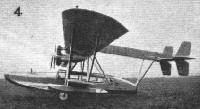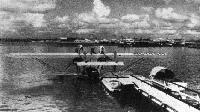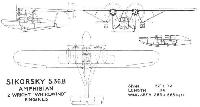
Варианты
- Sikorsky - S-36 / S-38 - 1927 - США
- Sikorsky - S-39 - 1929 - США
- Sikorsky - S-41 - 1930 - США
Sikorsky S-36 - S-39
Самолет S-36 можно по праву считать коммерчески успешной машиной. Самолет строился под требования "Pan American Airways" (PAA) на авиалайнер, способный совершать полеты по маршруту Сан-Хуан - Пуэрто-Рико вдоль линии островов. Всего компания приобрела пять машин, первая из них вышла на маршрут 4 февраля 1929 года (Майами - Панама). Еще один самолет, оснащенный носовой стрелковой точкой, под обозначением XPS-1 проходил испытания в ВМС США в качестве патрульного.
<...>
На базе S-36 был разработан S-38, оснащенный двумя двигателями Pratt & Whitney R-1340 Wasp мощностью 425 л. с. и способный брать на борт два члена экипажа и восемь пассажиров, совершая с ними перелет на дальность 966 км. Прототип S-38 был приобретен "NYRBA" и совершил первый полет 25 июня 1928 года, a "Pan Am" приобрела второй самолет данного типа и выставила его на маршрут 31 октября 1928 года. Всего PAA получила 38 S-38, которые в начале 1930-х годов использовались на маршрутах на Карибских и Гавайских островах.
Базовая модель S-38A оснащалась двигателями Wasp мощностью по 410 л.с., следом появилась модель S-38B с двигателями R-1340 мощностью по 425 л.с. и оснащенный такими же двигателями 14-местный вариант S-38C. S-38 использовались во многих компаниях. Последний самолет сняли с эксплуатации примерно в 1940-х годах.
Два S-38A были заказаны ВМС США в октябре 1928 года под обозначением XPS-2 и оснащались носовыми стрелковыми точками. Четыре S-38B под обозначением PS-3 строились в варианте с двигателями R-1340-7 мощностью по 450 л. с. и носовой и хвостовой стрелковыми точками. В 1929-1932 годах оценочные испытания проходили три машины, а в 1930 году, когда были заказаны еще три S-38B, самолет был переклассифицирован в вспомогательный. Обозначение XPS-2 сменили в итоге на XRS-2, a PS-3 - на RS-3, рассчитанный на перевозку шести пассажиров или равнозначного груза.
Авиакорпус Армии США в 1929-1930 годах приобрел 11 S-38A и использовал их в 1930-1933 годах под обозначениями C-6 и C-6A. Всего было собрано 114 единиц S-38.
<...>
Описание:
- Sikorsky S-36 - S-39
- Flight, October 1927
THE SIKORSKY S.36.B AMPHIBIAN
Фотографии
-
Мировая Авиация 236
Регистрационный номер: NC8000 Для карибских маршрутов компании "Pna Am" Чарльз Линдберг в феврале 1929 года совершил на этом S-38A (NC8000) трехдневный перелет по нескольким странам Латинской Америки протяженностью 3219 км.
-
Aeroplane Monthly 1999-06 / S.Harding - Flight of the Carnauba
Регистрационный номер: NC6V [8] The S-38 replica taxies to the dock after a water landing. The aircraft’s water handling is excellent, although, as with many seaplanes, water thrown on to the windscreen during take-off inhibits forward visibility in the early part of the run.
-
Aeroplane Monthly 1999-06 / S.Harding - Flight of the Carnauba
Регистрационный номер: NC6V [8] The replica makes a water turn, showing its array of bracing struts and wires. It is registered NC6V in the same series as the original, NC29V.
-
Aeroplane Monthly 1999-06 / S.Harding - Flight of the Carnauba
Регистрационный номер: NC6V [8] Resplendent in the same company livery worn by the original Carnauba, the S-38 replica departs on the 1998 expedition to Brazil. Built by Born Again Restorations, the aircraft is powered by twin Pratt & Whitney Wasp Junior radial engines.
-
Aeroplane Monthly 1999-06 / S.Harding - Flight of the Carnauba
Регистрационный номер: NC6V [8] The port Pratt & Whitney Wasp bellowing away next to the cockpit highlights the need for sound-suppressing earphones.
-
Aeroplane Monthly 1999-06 / S.Harding - Flight of the Carnauba
Регистрационный номер: NC6V [8] Last year the descendants of Johnson’s Wax company chairman H.F. Johnson emulated his 1935 survey flight to Brazil in a specially-built replica of his Sikorsky S-38
-
Aeroplane Monthly 1999-06 / S.Harding - Flight of the Carnauba
Регистрационный номер: NC6V [8] The Johnson family poses for a group portrait following the 1998 expedition’s return to the USA. From left to right they are: Curt Johnson; Winnie J. Marquart; Gene Johnson; Sam Johnson; Helen Johnson-Leipold; and Fisk Johnson.
-
Aeroplane Monthly 1993-06 / Personal album. Civil
Регистрационный номер: N3699 Igor Sikorsky’s S-36 gets an airing from Charles A. Lindbergh at Roosevelt Field on January 27, 1928. N3699 was leased to Pan Am for a brief period and is thought to have been dismantled by the factory upon completion of the S-38 prototype.
-
Мировая Авиация 236
S-36 представлял собой восьмиместный полутораплан - амфибию, оснащенную звездообразными двигателями Wright Whirlwind мощностью по 200л. с.
-
Flight 1927-10 / Flight
THE SIKORSKY S.36.B FLYING-BOAT: Two models are shown: left, the open type, and, right, the enclosed amphibian.
-
Flight 1932-01 / Flight
The Sikorsky Amphibian used on the expedition and flown by Robert A. Smith, at rest with its nose on the beach at Lake Yaxha, Guatemala. Its advent at first amazed the native Indian family, but they soon realised the huge bird from which white men stepped out meant no harm, and - as the picture shows - went on calmly with their daily tasks.
-
Flight 1927-10 / Flight
THE SIKORSKY S.36.B FLYING-BOAT: Three-quarter rear view of the open type. It is fitted with two Wright "Whirlwind" engines.
-
Flight 1929-02 / Flight
A SUCCESSFUL AMERICAN AMPHIBIAN: The Sikorsky S-38, fitted with two 410 h.p. Pratt and Whitney "Wasp" engines. Two of these machines were recently delivered to the U.S. Navy, and others are used by the Western Air Express and Pan American Airways on their commercial air mail and passenger routes.
-
Aviation Historian 20 / P.Jarrett - The Blue Falcon
Регистрационный номер: G-ABYS [8], NC15V [8] One of a sequence of glass-plate photographs taken of the Blue Falcon at Heston in April 1935, this shows the aircraft having its Pratt & Whitney Wasp engines run up. The S-38B was essentially similar to the S-38A, with more powerful engines and increased fuel capacity. By the time Francis acquired his, some 100 S-38s had been built for various customers.
-
Flight 1929-01 / Flight
THE CHICAGO AERO EXPOSITION: One of representative types of aircraft out of the seventy odd on view - (4) Sikorsky Amphibian 8-passenger transport (two 425 h.p. Pratt and Whitney" Wasps ")
-
Aviation Historian 20 / P.Jarrett - The Blue Falcon
Регистрационный номер: G-ABYS [8], NC15V [8] Bearing the name Blue Falcon on its hull and wearing its American registration, NC15V, Francis Francis’s Sikorsky S-38B. After its arrival in the UK in the late spring of 1932, it was registered G-ABYS, as seen on the rear hull in the photograph, taken at Heston in April 1935.
-
Aviation Historian 20 / P.Jarrett - The Blue Falcon
Регистрационный номер: G-ABYS [8], NC15V [8] The distinctive water tower in the background once again marks the location in this photograph as Heston. The amphibian was sometimes referred to as “The Explorer’s Air Yacht”, owing to its popularity with well-off private owners. Sikorsky’s first real commercial success, the S-38 made its maiden flight on June 25, 1928.
-
Flight 1932-09 / Flight
Регистрационный номер: G-ABYS [8], NC15V [8] SEA, LAND OR AIR: The Sikorsky (2 Wasps) of Mr. Francis Francis. The cabin is beautifully fitted, and this machine makes what is probably the most luxurious privately-owned aircraft in the country. It is in a similar Sikorsky that the Hutchinson family are flying to England, via Greenland, from New York.
-
Aeroplane Monthly 1989-06 / Personal album. Civil
Регистрационный номер: G-ABYS [8], NC15V [8] Francis Francis's Sikorsky S-38B G-ABYS photographed at its Heston base. Powered by two 425 h.p. Wasps, this 71ft 8in span air yacht cruised at 110 m.p.h. and originally cost around $50,000. Formerly NC15V, 'YS was later sold in France and on August 12, 1939 was lost in a crash at Calabar, Niger Colony.
-
Aviation Historian 20 / P.Jarrett - The Blue Falcon
Регистрационный номер: NC15V [8], G-ABYS [8] Bearing the name Blue Falcon on its hull and wearing its American registration, NC15V, Francis Francis’s Sikorsky S-38B is inspected at an unknown location. After its arrival in the UK in the late spring of 1932, it was registered G-ABYS.
-
Aviation Historian 20 / P.Jarrett - The Blue Falcon
For waterborne operations, the S-38’s undercarriage was retracted by means of an ingenious system in which the rubber-tyred mainwheels were fitted to a hinged axle attached to the hull, the outboard wheel hub being attached to a telescopic tube system, which was hydraulically raised to bring the wheels parallel with the wings.
-
Aeroplane Monthly 1999-06 / S.Harding - Flight of the Carnauba
Регистрационный номер: NC29V Martin and Osa Johnson spent two years and covered 60,000 miles in Africa in the 1930s on film work with Sikorsky S-39CS NC52V and S-38 NC29V.
Другие самолёты на фотографии: Sikorsky S-39 - США - 1929
-
Flight 1933-11 / Flight
ON SAFARI - WITH A CINE CAMERA: The two Sikorski amphibians - The Spirit of Africa with giraffe markings, and Osa's Ark with zebra markings - in which Mr. and Mrs. Martin Johnson have been carrying out an aerial expedition in Central Africa filming animal life.
Другие самолёты на фотографии: Sikorsky S-39 - США - 1929
-
Aeroplane Monthly 1999-06 / S.Harding - Flight of the Carnauba
Spirit of adventure: Osa and Martin Johnson (no relation to Sam) and crew members with the original Sikorsky S-38B Osa’s Ark, probably during their African tour in 1933. Like Carnauba, this aircraft is also being replicated by Born Again Restorations.
-
Aeroplane Monthly 1999-06 / S.Harding - Flight of the Carnauba
H.F. Johnson and his companions pose before their departure on the 1935 expedition. From left: Al Schlanser (chief pilot); J. Hoy (co-pilot/radio operator); H.F. Johnson; Robert Gardiner (purchasing agent); and J.V. Steinle (research director). The journey took three months and covered 15,500 miles.
-
Aviation Historian 20 / P.Jarrett - The Blue Falcon
Регистрационный номер: NC15V [8], G-ABYS [8] Minus its outer wings and tailbooms, the S-38 is carefully hoisted from the deck of the RMS Berengaria to the dock at Southampton on its arrival from the USA in the late spring of 1932. At this point it was still registered in the USA as NC15V, and there appears to be conflicting evidence about when its UK registration was applied.
-
Aviation Historian 20 / P.Jarrett - The Blue Falcon
Регистрационный номер: G-ABYS [8], NC15V [8] Following its stint in the UK as G-ABYS, the Blue Falcon was sold to French airline Aeromaritime, which was established in March 1935 to provide air services in French West and Equatorial Africa. In March 1936 the S-38 completed the airline’s first reconnaissance flight between Dakar (now in Senegal), Cotonou (Benin) and Pointe Noire (Republic of Congo).
-
Flight 1935-06 / Flight
Регистрационный номер: NC146M A Sikorsky S.38 alongside a typical landing stage, at San Juan, Porto Rico. The tanks for both engines are being refuelled simultaneously.
-
Flight 1930-02 / Flight
HAWAIIAN AIR TRANSPORT: Two Sikorsky S.38 amphibians of Inter-Island Airways about to start on the inaugural flight from John Rodgers Airport Honolulu, to Hilo
-
Flight 1932-09 / Flight
THE FAMILY TOUR: The Hutchinson family and crew, who attempted a flight from New York to Edinburgh in a Sikorsky amphibian, but came to grief in Greenland. Capt. George R. Hutchinson is shown seated with his wife and two daughters, Kathryn and Janet Lee. The others of the party are Peter Redpath, navigator, Joseph Ruff, mechanic, Gerald Altfilisch, radio operator, and Norman Alley, cameraman.
-
Авиация и Космонавтика 2020-03 / В.Морозов - Отчаянное время, отважные женщины
Гидросамолет «Сикорский» S-38, использующийся в качестве круизно-курортного транспорта. Тихоокеанское побережье США, начало 1930-х гг. Именно такую машину бразильские революционеры пытались угнать 25 сентября 1932 г. в г. Сан-Жуан-ди-Мерити.
-
Air International 1995-11 / G.Jones - Northwest is Northbest
Two Sikorsky S-43 amphibians were added to Northwest's fleet in 1931 to serve Duluth which did not have an airport.
-
Aeroplane Monthly 1999-06 / S.Harding - Flight of the Carnauba
Регистрационный номер: NC6V [8] The replica is authentic in virtually every detail, including the hand-crafted wooden furnishings of the cabin. Although elegant, the passenger compartment is very noisy, thanks to the proximity of the two Wasp Junior engines.
-
Aeroplane Monthly 1999-06 / S.Harding - Flight of the Carnauba
Регистрационный номер: NC6V [8] The replica’s nearly completed hull sits on a dolly at BAR’S workshop. A cross between a pontoon and a boat hull, the structure includes both fore and aft hull-top access hatches.
-
Flight 1927-10 / Flight
Sikorsky S.36.B Amphibian 2 Wright "Whirlwind" Engines
-
Aeroplane Monthly 1999-06 / S.Harding - Flight of the Carnauba
Sikorsky S-38B amphibian
- Фотографии





































